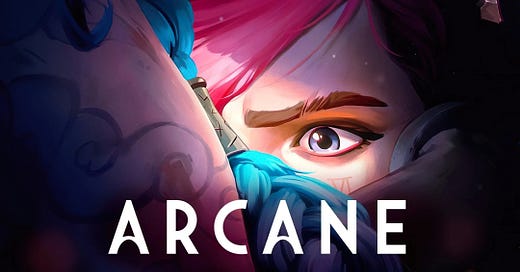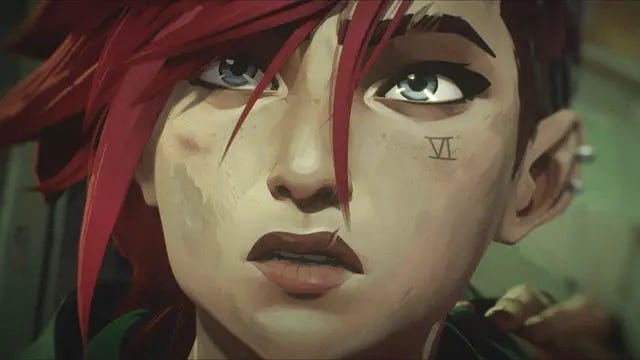Spoiler Warning for Netflix’s Arcane: League of Legends
Saturday, November 23rd at midnight, the final three episodes of hit animated series Arcane: League of Legends released on Netflix. The initial season released back in 2021, taking the world by storm with its unique art style and deviation from traditional storytelling lines. Inspired by the game League of Legends, Arcane tells the story of the class strife between Piltover, the glamorous and technologically advanced golden city, and Zaun, or the Undercity, which is aptly named.
The one of the plotlines that gripped the queer community concerned two of the key characters, Vi and Caitlyn. Vi and Caitlyn were set up as narrative foils in season one, both protectors of Zaun and Piltover respectively, who were dedicated to ‘doing the right thing’. Many of their scenes together were charged with romantic and sexual tension, which was not at all lost on queer viewers. Arcane creators shocked many, when the second season of the show was released, canonnizing their relationship together. Not only did the creators confirm their romantic intentions with each other in the early episodes of the season, they featured a several minute long sex scene in the final episodes.
Now, the CaitVi relationship, as it is often called in internet spaces, has been both highly praised and very much critisized. I liked it: here’s why.
The first thing that drew me to this relationship was how irrelevant their sexualities were to their lives. Arcane introduces to the audience a world that appears to not care at all about sexuality and even gender. There is no discussion of sexuality or gender, which is often a problematic thing, however there is no clear homophobia or bigotry to be found within the series. As opposed to ignoring queer struggles, Arcane seems to say “No, everyone’s cool with it here, they have other things to worry about.” I’ve consumed countless, not only queer stories, but specifically sapphic romances and I’m frankly so tired of the “we have to talk about what it means to be in a queer relationship” conversation. It’s a reality for many people, and something that doesn’t always need to be cut, but it has it’s time and place. I enjoyed being able to watch a sci-fi/fantasy show that is so far removed from our world and our perceptions of reality that the question of queerness was not a question at all.
One of the things I also enjoyed, which branches off of my previous point, is the subversion of traditional gender roles. Gender roles are so ingrained into society, even those that seek to break gender roles are often still wrapped up in the perception of them. Gender roles follow us all, queer or not. In sapphic spaces, we see this manifest often in stereotypical butch and femme relationships. Butch women are supposed to be hardened, stoic, strong, and capable. Femme women are emotional, soft, and near helpless. These so clearly reflect how we tend to perceive the masculine and feminine.
In Arcane, both Cait and Vi fall quite neatly into visual categories of gender roles. Vi is a boxer, sporting short hair and tattoos, the more masculine character. Cait comes from wealth and luxury, with long hair and outfits paired with skirts and ruffles. However, that is as far as the gender roles hold them. Vi is a very emotional character, crying often and seeking comfort and assistance. Caitlyn is standoffish, she is the pillar in their relationship, a shoulder for Vi to lean on. It can be very easy, as a creator, to project the ways in which society boxes us into our characters and it was incredibly refreshing to see two women that are women, not defined by masculinity or femininity.
Finally: my more controversial point. I like that these women are morally grey. They’re messy, they have horrible communication, they’re quick to judge each other, hurt each other, and they’re unendingly dramatic. Is this the world's best example of a healthy and safe sapphic relationship? No! Not only is it not supposed to be, it doesn’t have to be. Oftentimes, queer spaces insist on representation being perfect. This is a completely understandable standpoint; queer people have been demonized for decades, many crave a queer person they can look up to, a character they can point at and go “Look, we’re not evil or bad!”
But that’s not the reality. Queer people are ultimately people. We end up in toxic, messy relationships, but that doesn’t mean we stop rooting for each other. Not only that, but a dramatic relationship makes for good TV. It’s just simply true. Watching a couple go back and forth and safely establish boundaries might be some people’s idea of a wild night, but frankly watching a sapphic couple absolutely beat each other up only to come to each other, arms up and crying later is interesting. It holds your attention. These women are not even remotely perfect. They’re built mostly of trauma responses and a desperate need for survival. You don’t have to love it. But I do.
About the Author
Mya Tran is an incoming junior at Butler University, in Indianapolis, IN. They are currently studying English on the creative writing track and German. Growing up in a small college town with limited queer role models, Tran has spent her life with her nose in the books, looking for someone to relate to.







